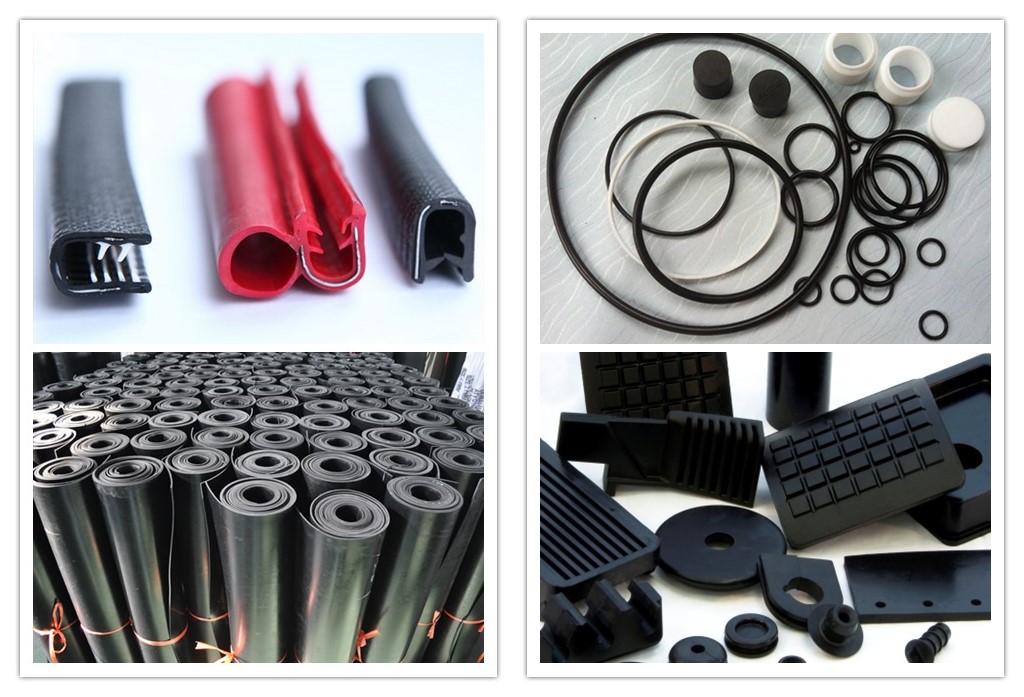Rubber Types

| Material | Property | Application |
| Natural Rubber(NR) | High elasticity, high tensile strength, excellent tear resistance and electrical insulation, good wear resistance and drought resistance, good processability, easy bonding of other materials, superior to synthetic rubber in overall performance. The disadvantages are poor resistance to oxygen and ozone, aging and deterioration, poor oil and solvent resistance, low acid-base corrosion resistance and heat resistance. Operating temperature range: about -60 °C ~ +80 °C. |
Production of tires, rubber shoes, hoses, tapes, wire & cable insulation and sheathing, and other general purpose products. Particularly suitable for torsional vibration dampers, engine dampers, machine supports, rubber-metal suspension elements, diaphragms, moulded products etc. |
| Styrene Butadiene Rubber(SBR) | Its performance is close to that of natural rubber, and its output is largest in common synthetic rubber currently. The abrasion resistance, aging resistance, and heat resistance exceed that of natural rubber, and its texture is evener than that of natural rubber. The disadvantages are low elasticity, poor resistance to flexion and tearing, poor processability, especially poor self-adhesion and low raw rubber strength. Operating temperature range: about -50 °C ~ +100 °C. |
Mainly replacing natural rubber and making rubber sheet, rubber hose, rubber shoes and other general products. |
| Neoprene(CR) | It has excellent resistance to oxygen, ozone resistance, non-flammable, self-extinguishing after ignition, oil and solvent resistance, acid and alkali resistance, aging resistance, good air tightness etc. Its physical and mechanical properties are also better than that of natural rubber, so it can be used as a general purpose rubber or as a specialty rubber. The disadvantages are poor cold resistance, large specific gravity, high relative cost, poor electrical insulating properties, stickiness during processing, scorching, and easy adhesion. In addition, the raw rubber has poor stability and is not easy to preserve. Operating temperature range: about -45 °C ~ +100 °C. |
It is mainly used for making cable jackets, various protective sleeves and covers required high resistance to ozone and aging. Making oil and chemical resistant hoses, tapes and chemical linings. Also making fire-resistant underground mining rubber products, various moulded products, seals, pads, adhesives etc. |
| Butyl(IIR) | The most prominent feature is good air tightness, ozone resistance, good aging resistance, high heat resistance, long-term working temperature below 130 °C. It’s able to resist inorganic strong acids (such as sulfuric acid, nitric acid etc) and general organic solvents, and has good vibration absorption and damping. Electrical insulation is also very good. The disadvantages are poor elasticity, poor processability, slow vulcanization, poor adhesion and oil resistance. Operating temperature range: about -40 °C ~ +120 °C. |
Mainly used for making inner tubes, water tires, balloons, wire and cable insulation, chemical equipment lining and shockproof products, heat resistant transport belts, heat and aging resistant tape products. |
| Nitrile(NBR) | The resistance to gasoline and aliphatic hydrocarbon oils is excellent, second only to polysulfide rubbers, acrylates and viton, and superior to other general purpose rubbers. Heat resistance, airtightness, wear resistance and water resistance are all good, and strong adhesion. The disadvantages are poor cold resistance and ozone resistance, low strength and elasticity, poor acid resistance, electrical insulation and polar solvent resistance. Operating temperature range: about -30 °C ~ +100 °C. |
Mainly used for making various oil-resistant products, such as hoses, sealed products. |
| Ethylene Propylene Rubber(EPDM) | Ozone resistance, UV resistance, weather resistance and aging resistance, ranking first in general rubber. Electrical insulation, chemical resistance, impact elasticity, acid and alkali resistance, small specific gravity, high filling compatibility. Heat resistance up to 150 °C, polar solvents (ketones, esters etc.), but not resistant to aliphatic and aromatic hydrocarbon. The physical and mechanical properties slightly inferior to that of natural rubber and better than that of SBR. The disadvantages are poor self-adhesion and mutual viscosity, and difficult to bond. Operating temperature range: about -50 °C ~ +150 °C. |
Mainly used to make lining of chemical equipment, wire and cable sheathing, steam hose, heat-resistant conveyor belt, automotive rubber products and other industrial products. |
| Silicone(VMQ) | Both high temperature (maximum 300 °C) and low temperature (minimum -100 °C), it is the best cold and high temperature resistant rubber currently. It also has excellent electrical insulation, high stability to thermal oxidation and ozone. Disadvantages are lower mechanical strength, poor oil resistance, solvent resistance, acid and alkali resistance, and expensive. Operating temperature: -60 °C ~ +200 °C. |
It is mainly used for making high and low temperature resistant products (rubber pipes, seals etc.), high temperature resistant wire and cable insulation. It is also used in food and medical industries because it is non-toxic and tasteless. |
| Viton(FKM/FPM) | Acid and alkali resistantance, oil resistance are the best in oil resistant rubber. High temperature resistance up to 300°C, it also has good resistance to radiation and high vacuum resistance. Electrical insulation, mechanical properties, chemical resistance, ozone resistance, atmospheric aging resistance are all excellent. Disadvantages are poor processing, expensive and poor cold resistance, low elasticity and air permeability. Operating temperature range: -20 °C ~ +200 °C. |
It is mainly used in the defense industry to making sealing materials and hoses for aircrafts and rockets required vacuum-resistant, high-temperature, chemical-resistant, or other parts . |
